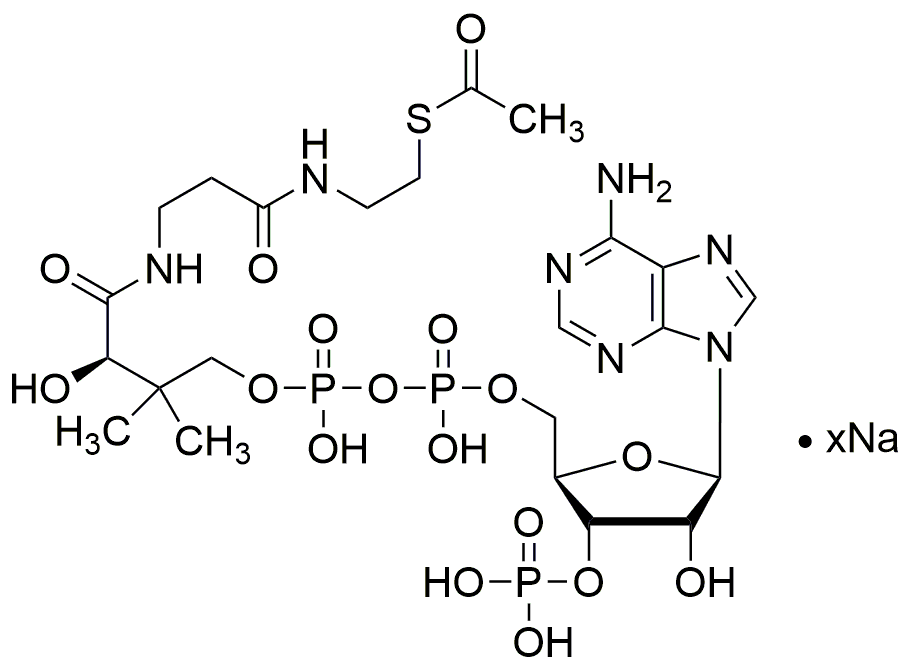Acetyl coenzyme A sodium salt is widely utilized in research focused on:
- Metabolic Studies: This compound plays a crucial role in cellular metabolism, serving as a key substrate in the synthesis of fatty acids and cholesterol. Researchers use it to study metabolic pathways and energy production in cells.
- Biochemical Research: It is essential for understanding enzyme activities and interactions in biochemical pathways. Scientists often employ it to investigate the mechanisms of various enzymes, aiding in drug discovery and development.
- Food Industry: The compound is used as a food additive, enhancing flavor and acting as a preservative. Its role in food chemistry helps improve product stability and shelf life.
- Pharmaceutical Applications: Acetyl coenzyme A sodium salt is involved in the formulation of certain medications, particularly those targeting metabolic disorders. Its use can enhance drug efficacy and bioavailability.
- Cosmetic Formulations: In the cosmetics industry, it is utilized for its moisturizing properties. Products containing this compound can improve skin hydration and overall texture, appealing to consumers looking for effective skincare solutions.
General Information
Properties
Safety and Regulations
Applications
Acetyl coenzyme A sodium salt is widely utilized in research focused on:
- Metabolic Studies: This compound plays a crucial role in cellular metabolism, serving as a key substrate in the synthesis of fatty acids and cholesterol. Researchers use it to study metabolic pathways and energy production in cells.
- Biochemical Research: It is essential for understanding enzyme activities and interactions in biochemical pathways. Scientists often employ it to investigate the mechanisms of various enzymes, aiding in drug discovery and development.
- Food Industry: The compound is used as a food additive, enhancing flavor and acting as a preservative. Its role in food chemistry helps improve product stability and shelf life.
- Pharmaceutical Applications: Acetyl coenzyme A sodium salt is involved in the formulation of certain medications, particularly those targeting metabolic disorders. Its use can enhance drug efficacy and bioavailability.
- Cosmetic Formulations: In the cosmetics industry, it is utilized for its moisturizing properties. Products containing this compound can improve skin hydration and overall texture, appealing to consumers looking for effective skincare solutions.
Documents
Safety Data Sheets (SDS)
The SDS provides comprehensive safety information on handling, storage, and disposal of the product.
Product Specification (PS)
The PS provides a comprehensive breakdown of the product’s properties, including chemical composition, physical state, purity, and storage requirements. It also details acceptable quality ranges and the product's intended applications.
Certificates of Analysis (COA)
Search for Certificates of Analysis (COA) by entering the products Lot Number. Lot and Batch Numbers can be found on a product’s label following the words ‘Lot’ or ‘Batch’.
*Catalog Number
*Lot Number
Certificates Of Origin (COO)
This COO confirms the country where the product was manufactured, and also details the materials and components used in it and whether it is derived from natural, synthetic, or other specific sources. This certificate may be required for customs, trade, and regulatory compliance.
*Catalog Number
*Lot Number
Safety Data Sheets (SDS)
The SDS provides comprehensive safety information on handling, storage, and disposal of the product.
DownloadProduct Specification (PS)
The PS provides a comprehensive breakdown of the product’s properties, including chemical composition, physical state, purity, and storage requirements. It also details acceptable quality ranges and the product's intended applications.
DownloadCertificates of Analysis (COA)
Search for Certificates of Analysis (COA) by entering the products Lot Number. Lot and Batch Numbers can be found on a product’s label following the words ‘Lot’ or ‘Batch’.
*Catalog Number
*Lot Number
Certificates Of Origin (COO)
This COO confirms the country where the product was manufactured, and also details the materials and components used in it and whether it is derived from natural, synthetic, or other specific sources. This certificate may be required for customs, trade, and regulatory compliance.


